Human Health Risk Assessment of PFAS Exposure at RAAF Richmond Base
VerifiedAdded on 2022/09/07
|9
|1820
|20
Report
AI Summary
This report presents a Human Health Risk Assessment (HHRA) of PFAS exposure at the Royal Australian Air Force (RAAF) Richmond Base. The assessment identifies the presence of PFAS in groundwater as the primary issue, highlighting potential health hazards like hormone suppression, high cholesterol, and cancer. The report details the stakeholders involved, including residents, defense personnel, and local government, and outlines the HHRA objectives, which include identifying exposure sources and pathways. The study assesses the toxicity of PFAS, considering threshold dose-response relationships and tolerable daily intake levels. Exposure assessment focuses on various pathways, such as incidental ingestion, dust inhalation, and dermal contact. The findings reveal that residents consuming home-grown eggs and meats may exceed the tolerable daily intake levels. The report concludes with recommendations to minimize PFAS exposure, particularly from home-grown produce, and emphasizes the need for immediate action to reduce contaminant exposure at the Richmond Base. The report references several scientific articles and provides figures to support its findings.
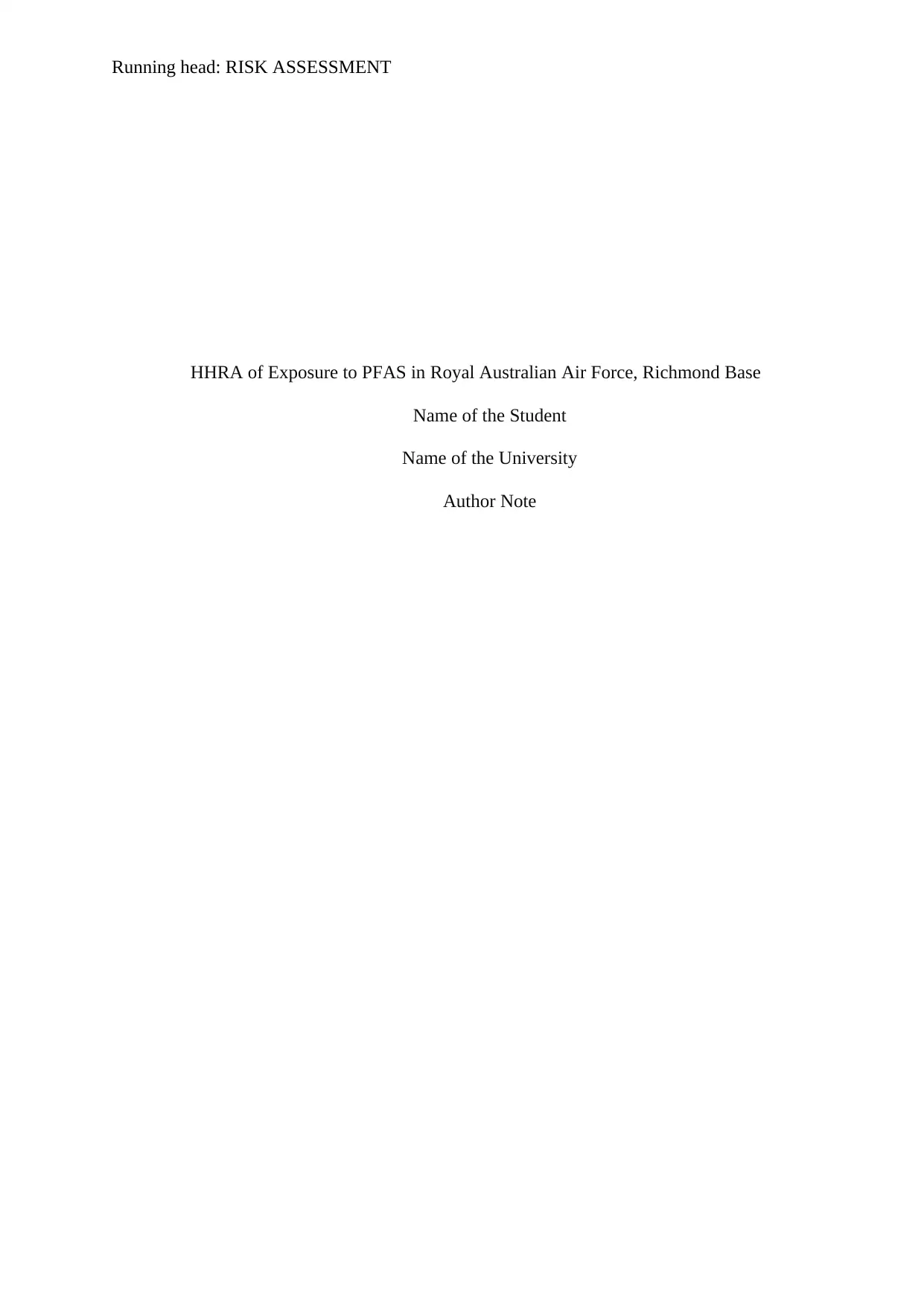
Running head: RISK ASSESSMENT
HHRA of Exposure to PFAS in Royal Australian Air Force, Richmond Base
Name of the Student
Name of the University
Author Note
HHRA of Exposure to PFAS in Royal Australian Air Force, Richmond Base
Name of the Student
Name of the University
Author Note
Paraphrase This Document
Need a fresh take? Get an instant paraphrase of this document with our AI Paraphraser
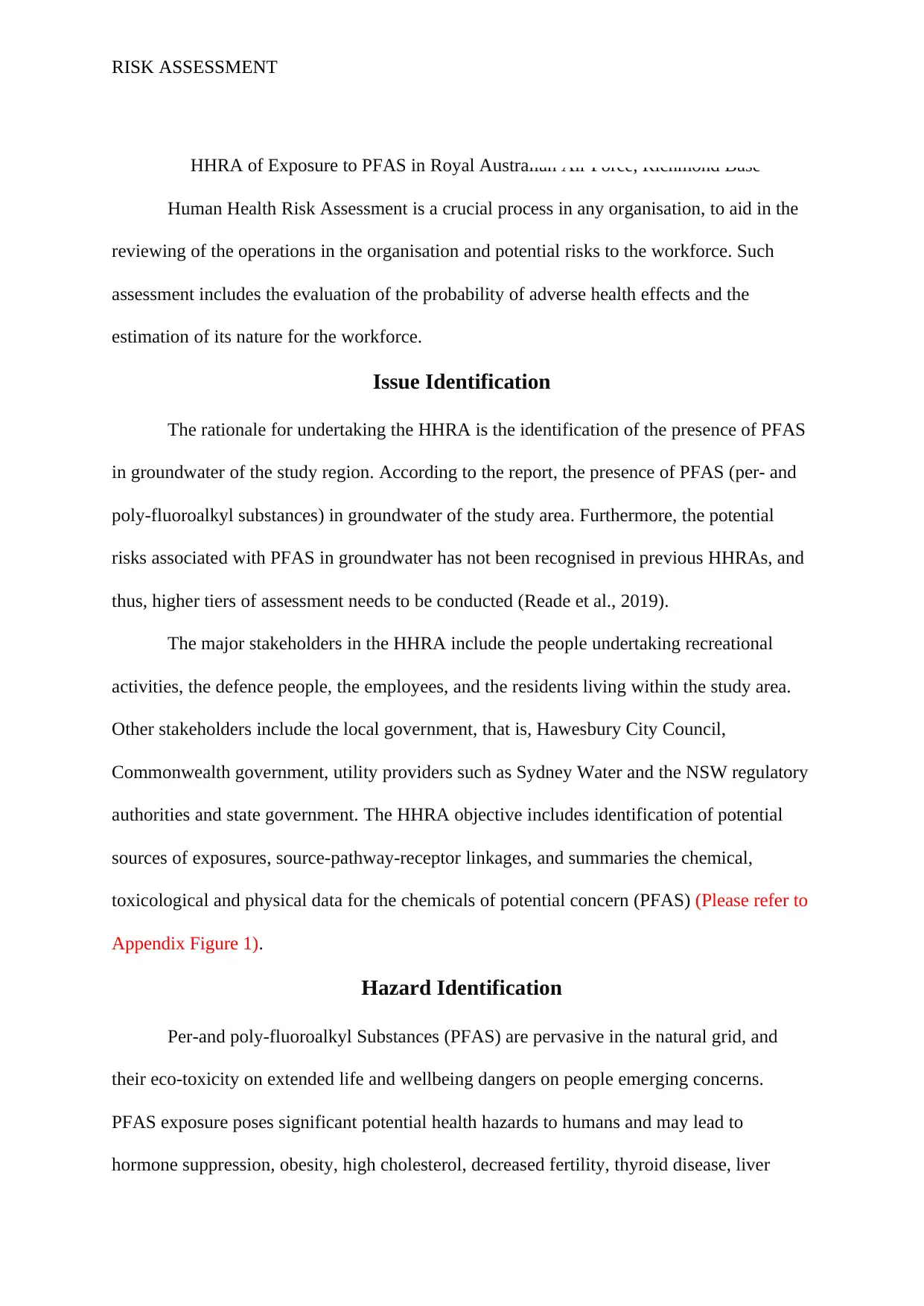
RISK ASSESSMENT
HHRA of Exposure to PFAS in Royal Australian Air Force, Richmond Base
Human Health Risk Assessment is a crucial process in any organisation, to aid in the
reviewing of the operations in the organisation and potential risks to the workforce. Such
assessment includes the evaluation of the probability of adverse health effects and the
estimation of its nature for the workforce.
Issue Identification
The rationale for undertaking the HHRA is the identification of the presence of PFAS
in groundwater of the study region. According to the report, the presence of PFAS (per- and
poly-fluoroalkyl substances) in groundwater of the study area. Furthermore, the potential
risks associated with PFAS in groundwater has not been recognised in previous HHRAs, and
thus, higher tiers of assessment needs to be conducted (Reade et al., 2019).
The major stakeholders in the HHRA include the people undertaking recreational
activities, the defence people, the employees, and the residents living within the study area.
Other stakeholders include the local government, that is, Hawesbury City Council,
Commonwealth government, utility providers such as Sydney Water and the NSW regulatory
authorities and state government. The HHRA objective includes identification of potential
sources of exposures, source-pathway-receptor linkages, and summaries the chemical,
toxicological and physical data for the chemicals of potential concern (PFAS) (Please refer to
Appendix Figure 1).
Hazard Identification
Per-and poly-fluoroalkyl Substances (PFAS) are pervasive in the natural grid, and
their eco-toxicity on extended life and wellbeing dangers on people emerging concerns.
PFAS exposure poses significant potential health hazards to humans and may lead to
hormone suppression, obesity, high cholesterol, decreased fertility, thyroid disease, liver
HHRA of Exposure to PFAS in Royal Australian Air Force, Richmond Base
Human Health Risk Assessment is a crucial process in any organisation, to aid in the
reviewing of the operations in the organisation and potential risks to the workforce. Such
assessment includes the evaluation of the probability of adverse health effects and the
estimation of its nature for the workforce.
Issue Identification
The rationale for undertaking the HHRA is the identification of the presence of PFAS
in groundwater of the study region. According to the report, the presence of PFAS (per- and
poly-fluoroalkyl substances) in groundwater of the study area. Furthermore, the potential
risks associated with PFAS in groundwater has not been recognised in previous HHRAs, and
thus, higher tiers of assessment needs to be conducted (Reade et al., 2019).
The major stakeholders in the HHRA include the people undertaking recreational
activities, the defence people, the employees, and the residents living within the study area.
Other stakeholders include the local government, that is, Hawesbury City Council,
Commonwealth government, utility providers such as Sydney Water and the NSW regulatory
authorities and state government. The HHRA objective includes identification of potential
sources of exposures, source-pathway-receptor linkages, and summaries the chemical,
toxicological and physical data for the chemicals of potential concern (PFAS) (Please refer to
Appendix Figure 1).
Hazard Identification
Per-and poly-fluoroalkyl Substances (PFAS) are pervasive in the natural grid, and
their eco-toxicity on extended life and wellbeing dangers on people emerging concerns.
PFAS exposure poses significant potential health hazards to humans and may lead to
hormone suppression, obesity, high cholesterol, decreased fertility, thyroid disease, liver
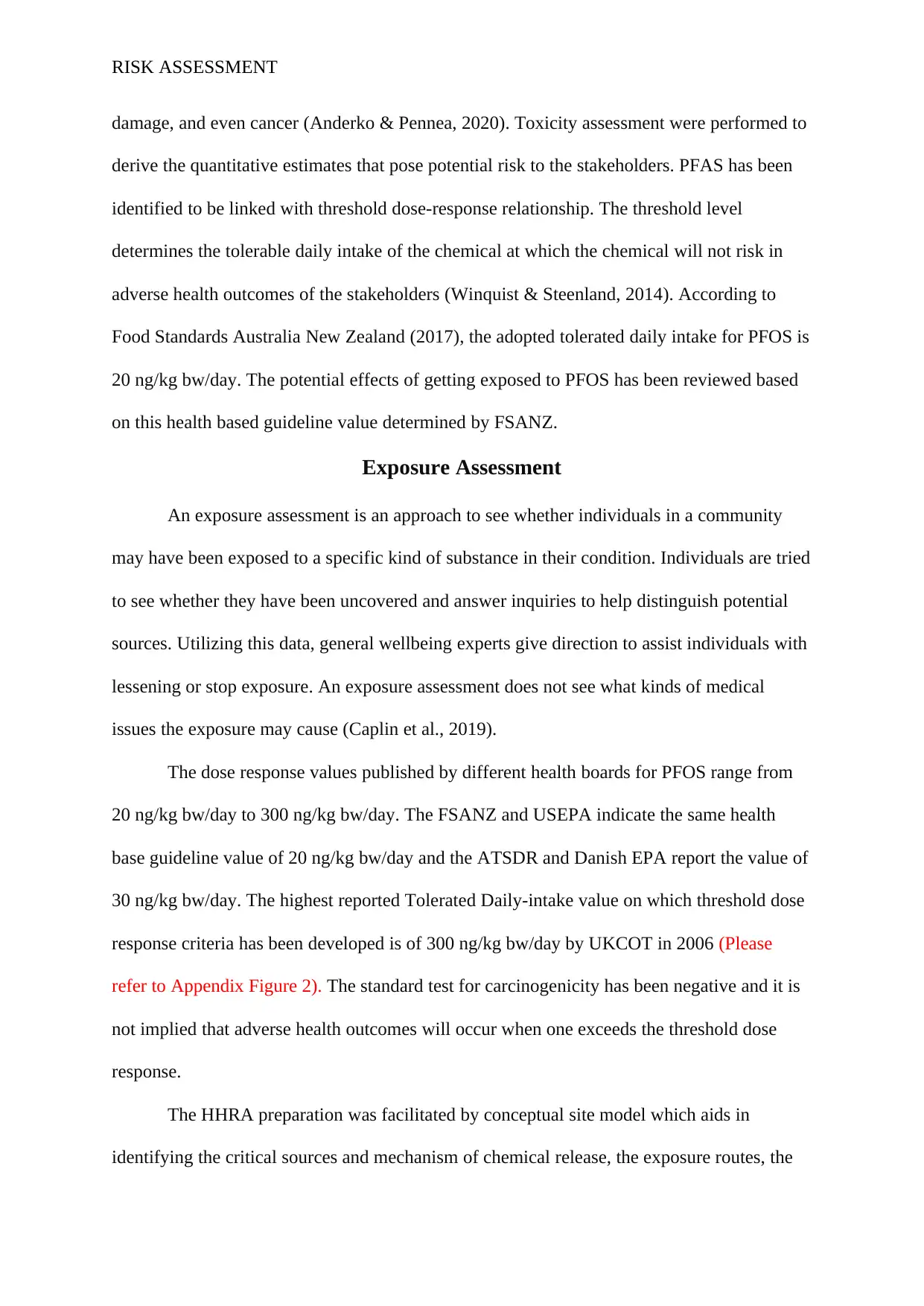
RISK ASSESSMENT
damage, and even cancer (Anderko & Pennea, 2020). Toxicity assessment were performed to
derive the quantitative estimates that pose potential risk to the stakeholders. PFAS has been
identified to be linked with threshold dose-response relationship. The threshold level
determines the tolerable daily intake of the chemical at which the chemical will not risk in
adverse health outcomes of the stakeholders (Winquist & Steenland, 2014). According to
Food Standards Australia New Zealand (2017), the adopted tolerated daily intake for PFOS is
20 ng/kg bw/day. The potential effects of getting exposed to PFOS has been reviewed based
on this health based guideline value determined by FSANZ.
Exposure Assessment
An exposure assessment is an approach to see whether individuals in a community
may have been exposed to a specific kind of substance in their condition. Individuals are tried
to see whether they have been uncovered and answer inquiries to help distinguish potential
sources. Utilizing this data, general wellbeing experts give direction to assist individuals with
lessening or stop exposure. An exposure assessment does not see what kinds of medical
issues the exposure may cause (Caplin et al., 2019).
The dose response values published by different health boards for PFOS range from
20 ng/kg bw/day to 300 ng/kg bw/day. The FSANZ and USEPA indicate the same health
base guideline value of 20 ng/kg bw/day and the ATSDR and Danish EPA report the value of
30 ng/kg bw/day. The highest reported Tolerated Daily-intake value on which threshold dose
response criteria has been developed is of 300 ng/kg bw/day by UKCOT in 2006 (Please
refer to Appendix Figure 2). The standard test for carcinogenicity has been negative and it is
not implied that adverse health outcomes will occur when one exceeds the threshold dose
response.
The HHRA preparation was facilitated by conceptual site model which aids in
identifying the critical sources and mechanism of chemical release, the exposure routes, the
damage, and even cancer (Anderko & Pennea, 2020). Toxicity assessment were performed to
derive the quantitative estimates that pose potential risk to the stakeholders. PFAS has been
identified to be linked with threshold dose-response relationship. The threshold level
determines the tolerable daily intake of the chemical at which the chemical will not risk in
adverse health outcomes of the stakeholders (Winquist & Steenland, 2014). According to
Food Standards Australia New Zealand (2017), the adopted tolerated daily intake for PFOS is
20 ng/kg bw/day. The potential effects of getting exposed to PFOS has been reviewed based
on this health based guideline value determined by FSANZ.
Exposure Assessment
An exposure assessment is an approach to see whether individuals in a community
may have been exposed to a specific kind of substance in their condition. Individuals are tried
to see whether they have been uncovered and answer inquiries to help distinguish potential
sources. Utilizing this data, general wellbeing experts give direction to assist individuals with
lessening or stop exposure. An exposure assessment does not see what kinds of medical
issues the exposure may cause (Caplin et al., 2019).
The dose response values published by different health boards for PFOS range from
20 ng/kg bw/day to 300 ng/kg bw/day. The FSANZ and USEPA indicate the same health
base guideline value of 20 ng/kg bw/day and the ATSDR and Danish EPA report the value of
30 ng/kg bw/day. The highest reported Tolerated Daily-intake value on which threshold dose
response criteria has been developed is of 300 ng/kg bw/day by UKCOT in 2006 (Please
refer to Appendix Figure 2). The standard test for carcinogenicity has been negative and it is
not implied that adverse health outcomes will occur when one exceeds the threshold dose
response.
The HHRA preparation was facilitated by conceptual site model which aids in
identifying the critical sources and mechanism of chemical release, the exposure routes, the
⊘ This is a preview!⊘
Do you want full access?
Subscribe today to unlock all pages.

Trusted by 1+ million students worldwide
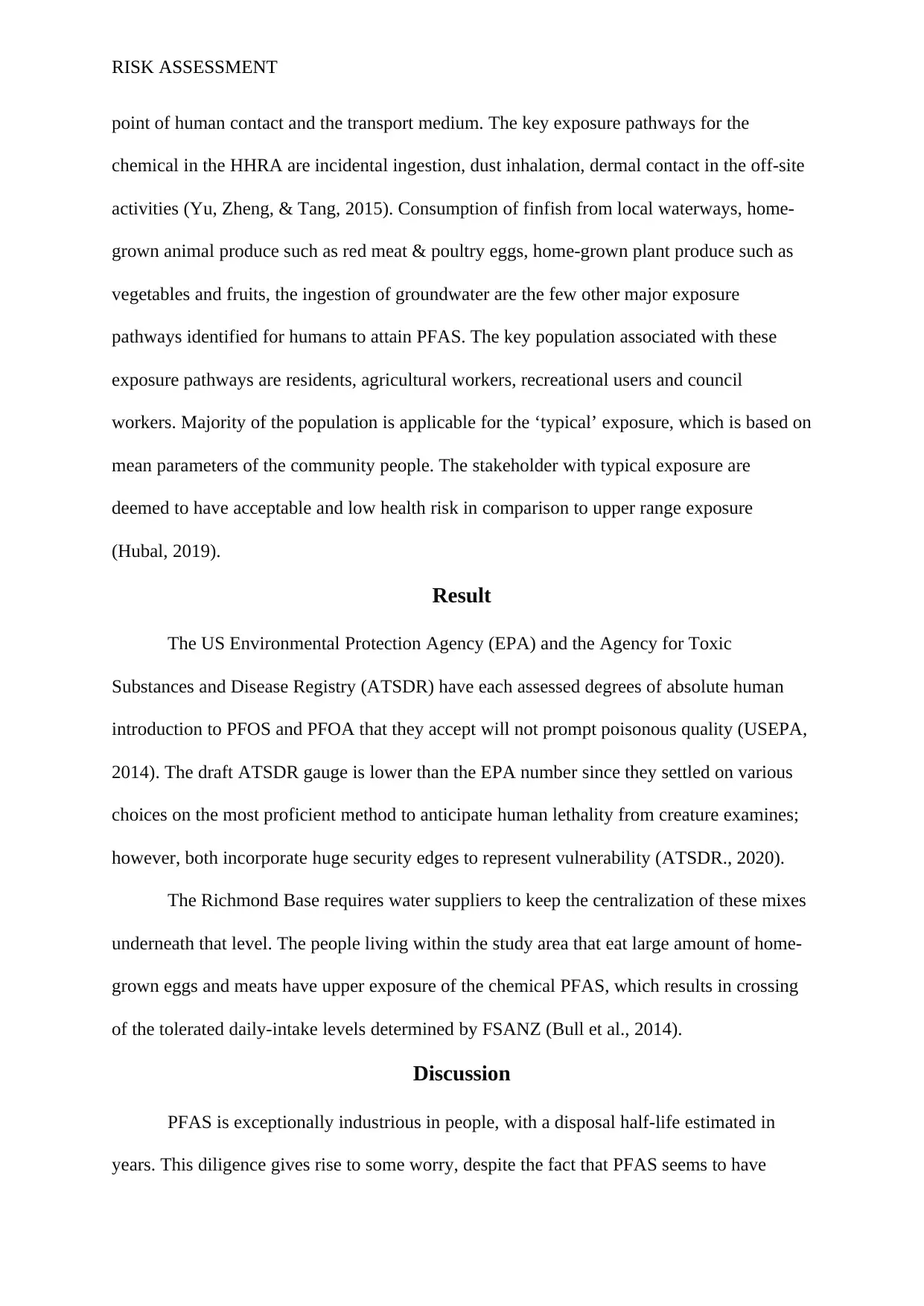
RISK ASSESSMENT
point of human contact and the transport medium. The key exposure pathways for the
chemical in the HHRA are incidental ingestion, dust inhalation, dermal contact in the off-site
activities (Yu, Zheng, & Tang, 2015). Consumption of finfish from local waterways, home-
grown animal produce such as red meat & poultry eggs, home-grown plant produce such as
vegetables and fruits, the ingestion of groundwater are the few other major exposure
pathways identified for humans to attain PFAS. The key population associated with these
exposure pathways are residents, agricultural workers, recreational users and council
workers. Majority of the population is applicable for the ‘typical’ exposure, which is based on
mean parameters of the community people. The stakeholder with typical exposure are
deemed to have acceptable and low health risk in comparison to upper range exposure
(Hubal, 2019).
Result
The US Environmental Protection Agency (EPA) and the Agency for Toxic
Substances and Disease Registry (ATSDR) have each assessed degrees of absolute human
introduction to PFOS and PFOA that they accept will not prompt poisonous quality (USEPA,
2014). The draft ATSDR gauge is lower than the EPA number since they settled on various
choices on the most proficient method to anticipate human lethality from creature examines;
however, both incorporate huge security edges to represent vulnerability (ATSDR., 2020).
The Richmond Base requires water suppliers to keep the centralization of these mixes
underneath that level. The people living within the study area that eat large amount of home-
grown eggs and meats have upper exposure of the chemical PFAS, which results in crossing
of the tolerated daily-intake levels determined by FSANZ (Bull et al., 2014).
Discussion
PFAS is exceptionally industrious in people, with a disposal half-life estimated in
years. This diligence gives rise to some worry, despite the fact that PFAS seems to have
point of human contact and the transport medium. The key exposure pathways for the
chemical in the HHRA are incidental ingestion, dust inhalation, dermal contact in the off-site
activities (Yu, Zheng, & Tang, 2015). Consumption of finfish from local waterways, home-
grown animal produce such as red meat & poultry eggs, home-grown plant produce such as
vegetables and fruits, the ingestion of groundwater are the few other major exposure
pathways identified for humans to attain PFAS. The key population associated with these
exposure pathways are residents, agricultural workers, recreational users and council
workers. Majority of the population is applicable for the ‘typical’ exposure, which is based on
mean parameters of the community people. The stakeholder with typical exposure are
deemed to have acceptable and low health risk in comparison to upper range exposure
(Hubal, 2019).
Result
The US Environmental Protection Agency (EPA) and the Agency for Toxic
Substances and Disease Registry (ATSDR) have each assessed degrees of absolute human
introduction to PFOS and PFOA that they accept will not prompt poisonous quality (USEPA,
2014). The draft ATSDR gauge is lower than the EPA number since they settled on various
choices on the most proficient method to anticipate human lethality from creature examines;
however, both incorporate huge security edges to represent vulnerability (ATSDR., 2020).
The Richmond Base requires water suppliers to keep the centralization of these mixes
underneath that level. The people living within the study area that eat large amount of home-
grown eggs and meats have upper exposure of the chemical PFAS, which results in crossing
of the tolerated daily-intake levels determined by FSANZ (Bull et al., 2014).
Discussion
PFAS is exceptionally industrious in people, with a disposal half-life estimated in
years. This diligence gives rise to some worry, despite the fact that PFAS seems to have
Paraphrase This Document
Need a fresh take? Get an instant paraphrase of this document with our AI Paraphraser
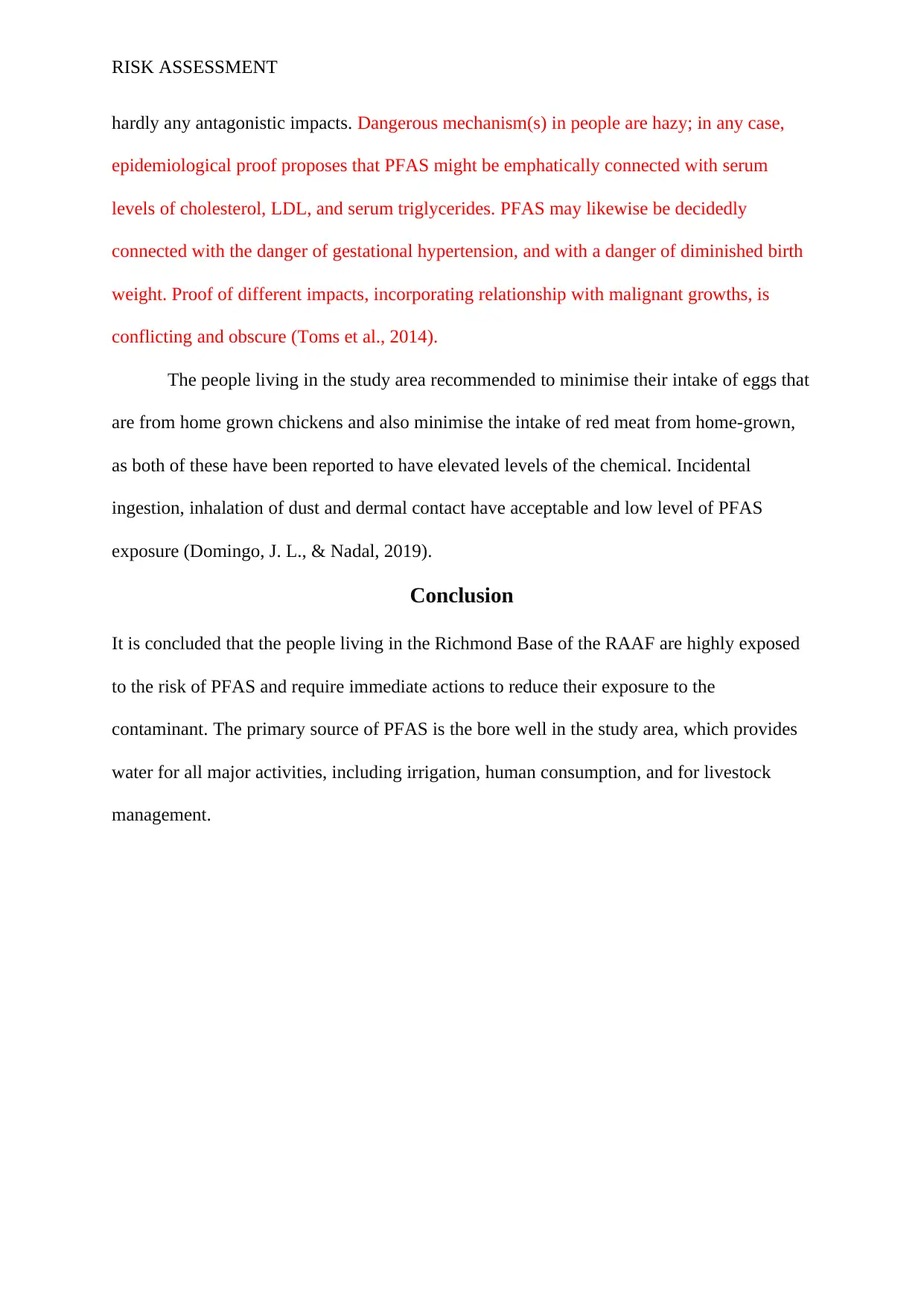
RISK ASSESSMENT
hardly any antagonistic impacts. Dangerous mechanism(s) in people are hazy; in any case,
epidemiological proof proposes that PFAS might be emphatically connected with serum
levels of cholesterol, LDL, and serum triglycerides. PFAS may likewise be decidedly
connected with the danger of gestational hypertension, and with a danger of diminished birth
weight. Proof of different impacts, incorporating relationship with malignant growths, is
conflicting and obscure (Toms et al., 2014).
The people living in the study area recommended to minimise their intake of eggs that
are from home grown chickens and also minimise the intake of red meat from home-grown,
as both of these have been reported to have elevated levels of the chemical. Incidental
ingestion, inhalation of dust and dermal contact have acceptable and low level of PFAS
exposure (Domingo, J. L., & Nadal, 2019).
Conclusion
It is concluded that the people living in the Richmond Base of the RAAF are highly exposed
to the risk of PFAS and require immediate actions to reduce their exposure to the
contaminant. The primary source of PFAS is the bore well in the study area, which provides
water for all major activities, including irrigation, human consumption, and for livestock
management.
hardly any antagonistic impacts. Dangerous mechanism(s) in people are hazy; in any case,
epidemiological proof proposes that PFAS might be emphatically connected with serum
levels of cholesterol, LDL, and serum triglycerides. PFAS may likewise be decidedly
connected with the danger of gestational hypertension, and with a danger of diminished birth
weight. Proof of different impacts, incorporating relationship with malignant growths, is
conflicting and obscure (Toms et al., 2014).
The people living in the study area recommended to minimise their intake of eggs that
are from home grown chickens and also minimise the intake of red meat from home-grown,
as both of these have been reported to have elevated levels of the chemical. Incidental
ingestion, inhalation of dust and dermal contact have acceptable and low level of PFAS
exposure (Domingo, J. L., & Nadal, 2019).
Conclusion
It is concluded that the people living in the Richmond Base of the RAAF are highly exposed
to the risk of PFAS and require immediate actions to reduce their exposure to the
contaminant. The primary source of PFAS is the bore well in the study area, which provides
water for all major activities, including irrigation, human consumption, and for livestock
management.
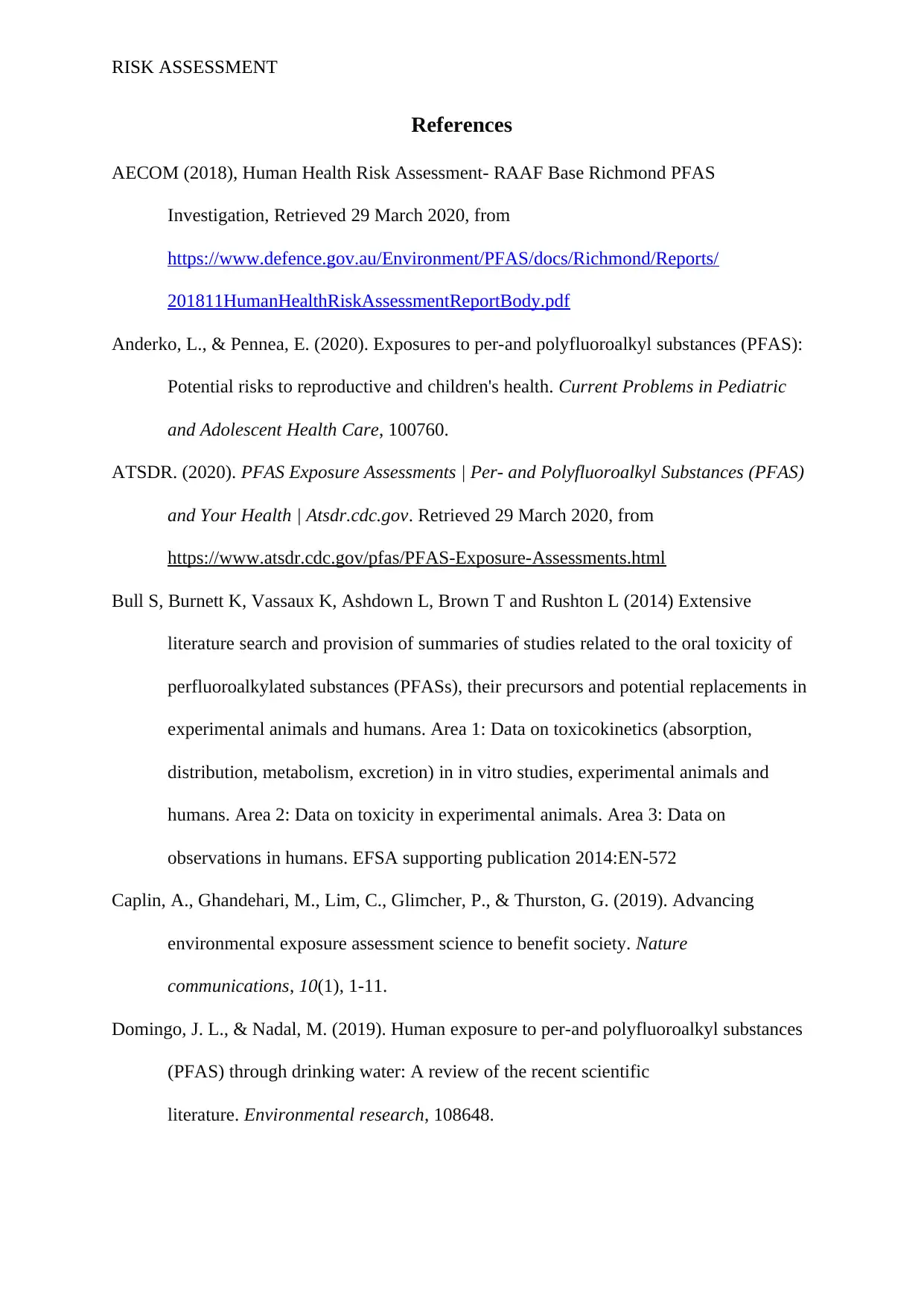
RISK ASSESSMENT
References
AECOM (2018), Human Health Risk Assessment- RAAF Base Richmond PFAS
Investigation, Retrieved 29 March 2020, from
https://www.defence.gov.au/Environment/PFAS/docs/Richmond/Reports/
201811HumanHealthRiskAssessmentReportBody.pdf
Anderko, L., & Pennea, E. (2020). Exposures to per-and polyfluoroalkyl substances (PFAS):
Potential risks to reproductive and children's health. Current Problems in Pediatric
and Adolescent Health Care, 100760.
ATSDR. (2020). PFAS Exposure Assessments | Per- and Polyfluoroalkyl Substances (PFAS)
and Your Health | Atsdr.cdc.gov. Retrieved 29 March 2020, from
https://www.atsdr.cdc.gov/pfas/PFAS-Exposure-Assessments.html
Bull S, Burnett K, Vassaux K, Ashdown L, Brown T and Rushton L (2014) Extensive
literature search and provision of summaries of studies related to the oral toxicity of
perfluoroalkylated substances (PFASs), their precursors and potential replacements in
experimental animals and humans. Area 1: Data on toxicokinetics (absorption,
distribution, metabolism, excretion) in in vitro studies, experimental animals and
humans. Area 2: Data on toxicity in experimental animals. Area 3: Data on
observations in humans. EFSA supporting publication 2014:EN-572
Caplin, A., Ghandehari, M., Lim, C., Glimcher, P., & Thurston, G. (2019). Advancing
environmental exposure assessment science to benefit society. Nature
communications, 10(1), 1-11.
Domingo, J. L., & Nadal, M. (2019). Human exposure to per-and polyfluoroalkyl substances
(PFAS) through drinking water: A review of the recent scientific
literature. Environmental research, 108648.
References
AECOM (2018), Human Health Risk Assessment- RAAF Base Richmond PFAS
Investigation, Retrieved 29 March 2020, from
https://www.defence.gov.au/Environment/PFAS/docs/Richmond/Reports/
201811HumanHealthRiskAssessmentReportBody.pdf
Anderko, L., & Pennea, E. (2020). Exposures to per-and polyfluoroalkyl substances (PFAS):
Potential risks to reproductive and children's health. Current Problems in Pediatric
and Adolescent Health Care, 100760.
ATSDR. (2020). PFAS Exposure Assessments | Per- and Polyfluoroalkyl Substances (PFAS)
and Your Health | Atsdr.cdc.gov. Retrieved 29 March 2020, from
https://www.atsdr.cdc.gov/pfas/PFAS-Exposure-Assessments.html
Bull S, Burnett K, Vassaux K, Ashdown L, Brown T and Rushton L (2014) Extensive
literature search and provision of summaries of studies related to the oral toxicity of
perfluoroalkylated substances (PFASs), their precursors and potential replacements in
experimental animals and humans. Area 1: Data on toxicokinetics (absorption,
distribution, metabolism, excretion) in in vitro studies, experimental animals and
humans. Area 2: Data on toxicity in experimental animals. Area 3: Data on
observations in humans. EFSA supporting publication 2014:EN-572
Caplin, A., Ghandehari, M., Lim, C., Glimcher, P., & Thurston, G. (2019). Advancing
environmental exposure assessment science to benefit society. Nature
communications, 10(1), 1-11.
Domingo, J. L., & Nadal, M. (2019). Human exposure to per-and polyfluoroalkyl substances
(PFAS) through drinking water: A review of the recent scientific
literature. Environmental research, 108648.
⊘ This is a preview!⊘
Do you want full access?
Subscribe today to unlock all pages.

Trusted by 1+ million students worldwide
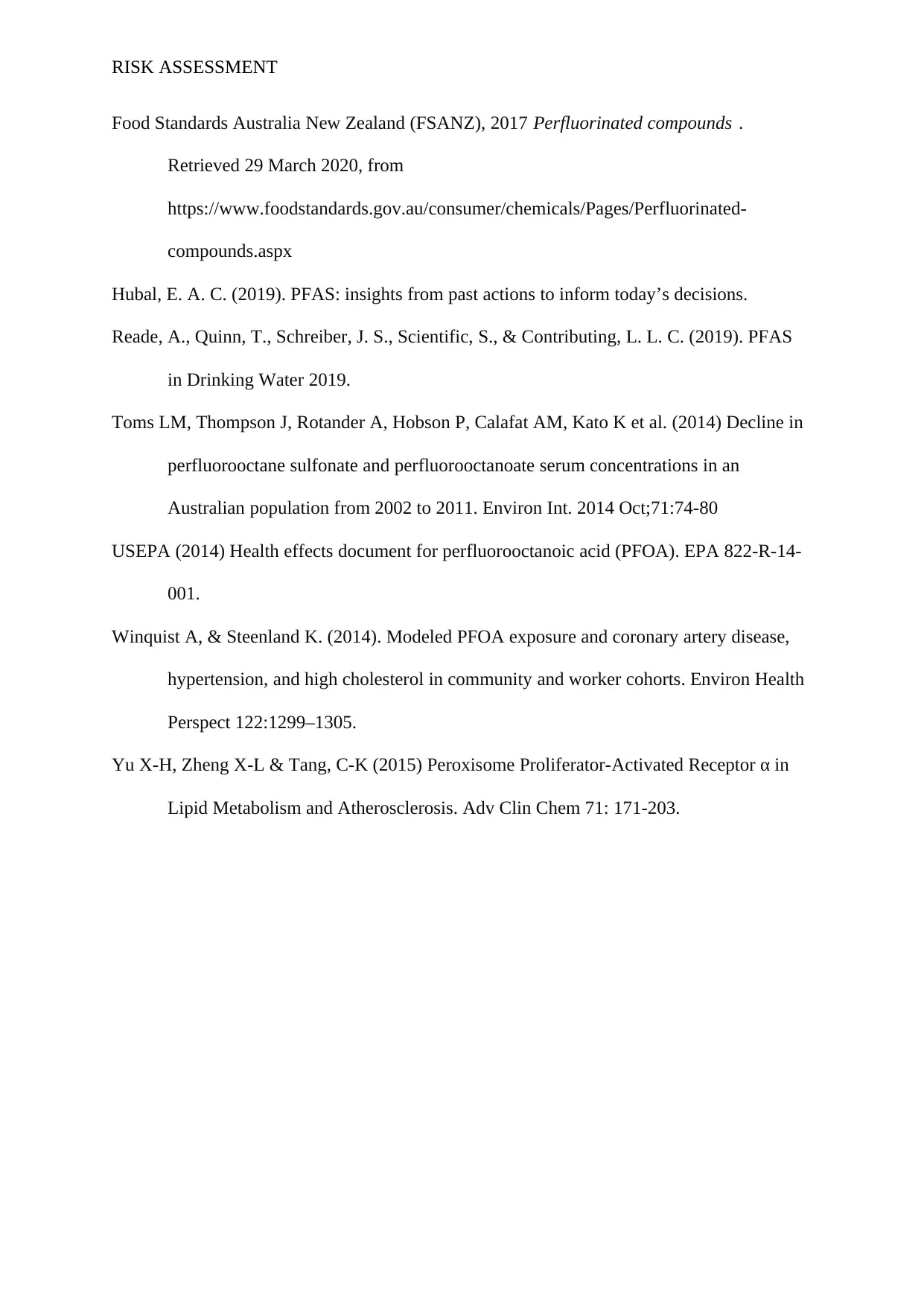
RISK ASSESSMENT
Food Standards Australia New Zealand (FSANZ), 2017 Perfluorinated compounds .
Retrieved 29 March 2020, from
https://www.foodstandards.gov.au/consumer/chemicals/Pages/Perfluorinated-
compounds.aspx
Hubal, E. A. C. (2019). PFAS: insights from past actions to inform today’s decisions.
Reade, A., Quinn, T., Schreiber, J. S., Scientific, S., & Contributing, L. L. C. (2019). PFAS
in Drinking Water 2019.
Toms LM, Thompson J, Rotander A, Hobson P, Calafat AM, Kato K et al. (2014) Decline in
perfluorooctane sulfonate and perfluorooctanoate serum concentrations in an
Australian population from 2002 to 2011. Environ Int. 2014 Oct;71:74-80
USEPA (2014) Health effects document for perfluorooctanoic acid (PFOA). EPA 822-R-14-
001.
Winquist A, & Steenland K. (2014). Modeled PFOA exposure and coronary artery disease,
hypertension, and high cholesterol in community and worker cohorts. Environ Health
Perspect 122:1299–1305.
Yu X-H, Zheng X-L & Tang, C-K (2015) Peroxisome Proliferator-Activated Receptor α in
Lipid Metabolism and Atherosclerosis. Adv Clin Chem 71: 171-203.
Food Standards Australia New Zealand (FSANZ), 2017 Perfluorinated compounds .
Retrieved 29 March 2020, from
https://www.foodstandards.gov.au/consumer/chemicals/Pages/Perfluorinated-
compounds.aspx
Hubal, E. A. C. (2019). PFAS: insights from past actions to inform today’s decisions.
Reade, A., Quinn, T., Schreiber, J. S., Scientific, S., & Contributing, L. L. C. (2019). PFAS
in Drinking Water 2019.
Toms LM, Thompson J, Rotander A, Hobson P, Calafat AM, Kato K et al. (2014) Decline in
perfluorooctane sulfonate and perfluorooctanoate serum concentrations in an
Australian population from 2002 to 2011. Environ Int. 2014 Oct;71:74-80
USEPA (2014) Health effects document for perfluorooctanoic acid (PFOA). EPA 822-R-14-
001.
Winquist A, & Steenland K. (2014). Modeled PFOA exposure and coronary artery disease,
hypertension, and high cholesterol in community and worker cohorts. Environ Health
Perspect 122:1299–1305.
Yu X-H, Zheng X-L & Tang, C-K (2015) Peroxisome Proliferator-Activated Receptor α in
Lipid Metabolism and Atherosclerosis. Adv Clin Chem 71: 171-203.
Paraphrase This Document
Need a fresh take? Get an instant paraphrase of this document with our AI Paraphraser
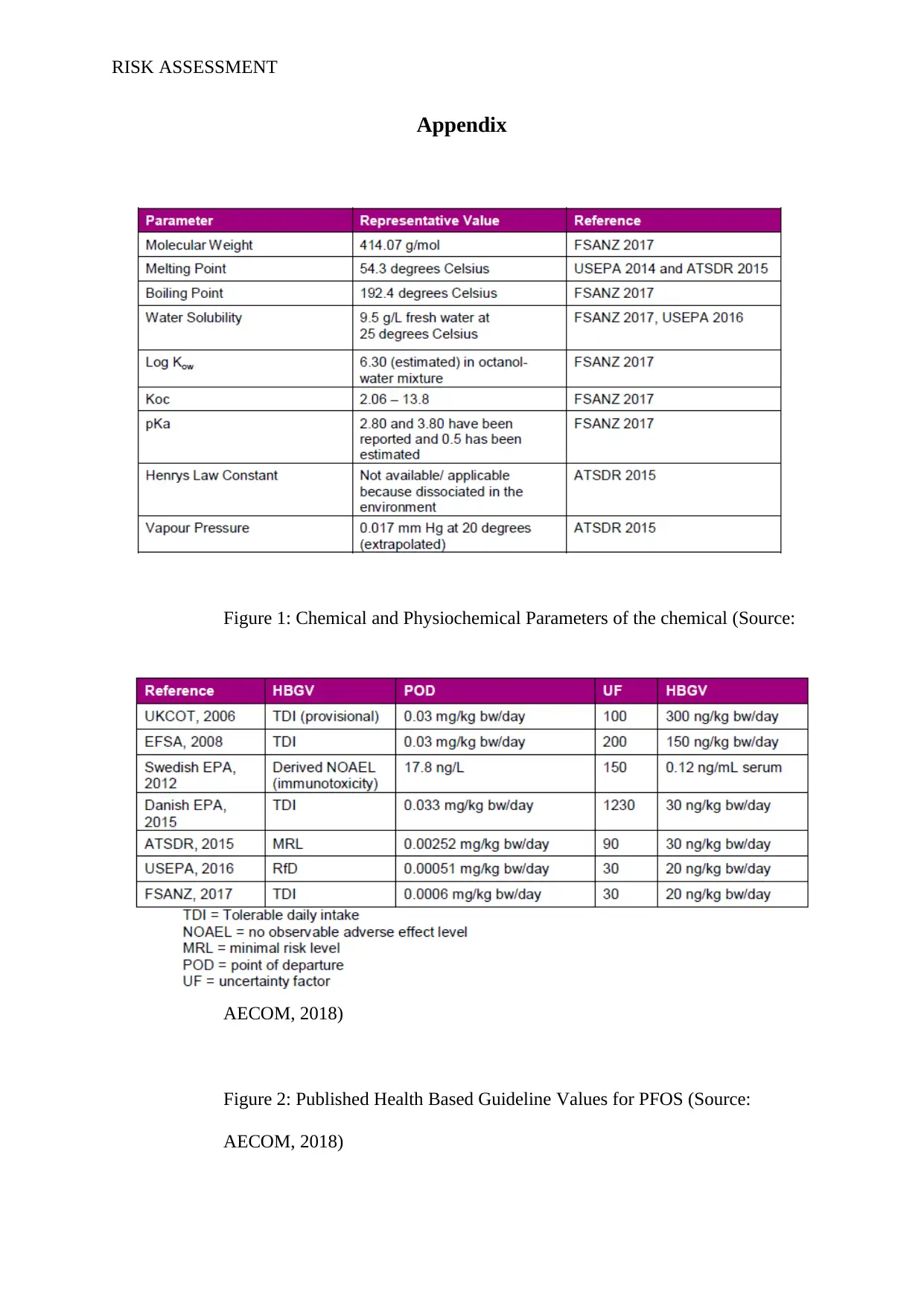
RISK ASSESSMENT
Appendix
Figure 1: Chemical and Physiochemical Parameters of the chemical (Source:
AECOM, 2018)
Figure 2: Published Health Based Guideline Values for PFOS (Source:
AECOM, 2018)
Appendix
Figure 1: Chemical and Physiochemical Parameters of the chemical (Source:
AECOM, 2018)
Figure 2: Published Health Based Guideline Values for PFOS (Source:
AECOM, 2018)

RISK ASSESSMENT
⊘ This is a preview!⊘
Do you want full access?
Subscribe today to unlock all pages.

Trusted by 1+ million students worldwide
1 out of 9
Your All-in-One AI-Powered Toolkit for Academic Success.
+13062052269
info@desklib.com
Available 24*7 on WhatsApp / Email
![[object Object]](/_next/static/media/star-bottom.7253800d.svg)
Unlock your academic potential
Copyright © 2020–2025 A2Z Services. All Rights Reserved. Developed and managed by ZUCOL.